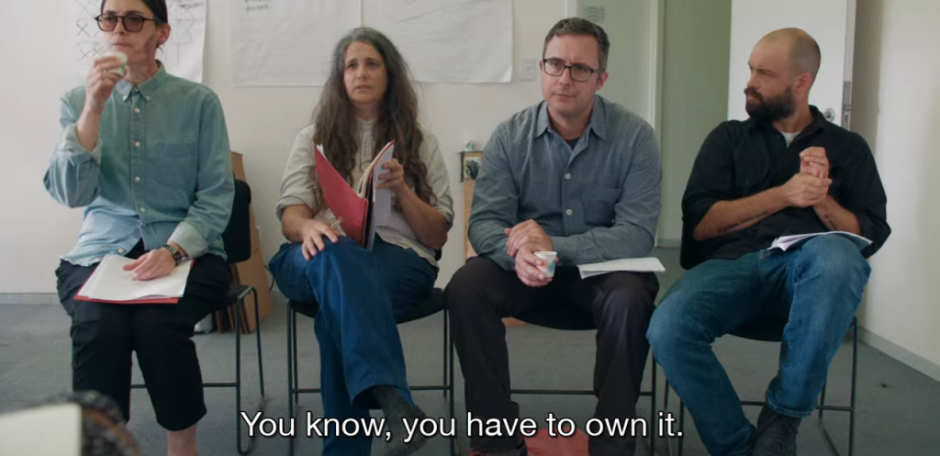Signature pedagogies: are discipline specific pedagogies that model professional modes of thinking and acting to students (Schulman, 2005 as cited in (Orr and Shreeve, 2017,p.88).
The studio: a space that allows for fluid social learning. This description of the studio where every student has an individual space where they can leave the work for as long as they wish is structurally impossible at Chelsea and not good modelling considering the current context of practices after college. It was never available to most students after college anyway according to gender/class/disabilities/etc. Students are more and more in full time work, having caring duties, and disability attendance issues which requires a new set of understandings of what the studio can and should be.
The live project: A simulation of the tension between industry expectation/briefs and the learning outcomes pushed by college. Art examples given are working with a ‘local gallery’ or ‘site-specific work’ but those examples don’t involve briefs. More pertinent for us in an art context, is less the idea of negotiating different demands (risk assessments, proposals for specific spaces, copyright regulations according to the situation, relations with participants, crits with curators, applications for funding. Etc).
Materiality:
There is a weird distinction here about the writing as being done in private and the ‘material’ as being developed in public that doesn’t really apply to our course. Writing here is expected to exist as a tool for personal self-reflection which might work for design but again, has a slightly different role in an art context. We think about text as an extension of the criticality and public making that exist in the practice.
“In summary the authors of the artists’ intervention report (Thomson et al., 2012) state: It was observable across all of the sessions that the practitioners were at pains to stress to the students that there was no definitive right or wrong answer to artistic problems. The emphasis was on whether the work looked and/or felt right to the student in the context of what else was happening in the class. So standards were apparent and applied, but individuals were expected to develop their own skills of discrimination and judgement. There was therefore a stronger orientation towards intrinsic rather than extrinsic motivation and evaluation in the artists’ sessions. “
(Orr and Shreeve, 2017, p. 96)
Teaching Strategies/ the real life problematic: It explores the different way lecturers might explore and translate the tensions and overlaps between their teaching and their practices, between enabling learning and making a product (or having a practice, again no Fine Arts specificity).
“This may be dependent on individual’s participation, the number of students in relation to the activity may hinder apprehension or the activity will only mirror practice and not enable access to understanding practice principles. […] Within learning activities it is important for students to access the underlying reasons why certain things are done rather than only access the processes. Simply using the references to the practice actually excludes the students from developing an understanding; they require access or the ‘routes of development’ to fully under- stand the practice principles to contextualise the broader framework of practice as a lived experience. “
(Orr and Shreeve, 2017, p. 100)
The use of mirroring in that quote is astute. There is a constant danger in the current pressure to format assessments and tasks after real-life examples like writing press-releases, that focus on the production of a final object that “looks like the real-life object”. Something akin to asking a student to be chat GPT, ignoring the underlying skills and processes that should be learnt. The critique of the positioning of industry or ‘the real world’ as a way to keep education subservient is also quite insightful, even though it seems to contradict the spirit of the text which seems to see the university as a place to create professionals to feed the industry, not as a place for development and emancipation.
Dwelling: One paragraph on fine art specific pedagogies, although quite superficial and dismissive. It’s all from one text, Dwelling as an Approach to Creative Pedagogy (Hughes, 2014). “For an art student, however, there is no industry rather a range of practices into which they will establish their own version of art practice or practices. “(Orr and Shreeve, 2017, p. 103) Hughes point about long term engagement with certain ideas comes closer to what developing an art practice requires. After almost 10 years at Chelsea hearing about how UAL has truncated the units more and more and disconnected students from their practice by demanding tasks and assessments that promote a project-based teaching, it makes sense to see the ideological biases behind those changes.
References
Hughes, D. (2014) ‘Dwelling as an approach to creative pedagogy’, Art, Design & Communication in Higher Education, 13(1), pp. 73–85. Available at: https://doi.org/10.1386/adch.13.1.73_1.
McDonald, J.K. and Michela, E. (2019) ‘The design critique and the moral goods of studio pedagogy’, Design Studies, 62, pp. 1–35. Available at: https://doi.org/10.1016/j.destud.2019.02.001.
Orr, S. and Shreeve, A. (2017) ‘Teaching practices for creative practitioners’, in Art and design pedagogy in higher education: Knowledge, values and ambiguity in the creative curriculum. Milton: Taylor and Francis Group (Routledge Research in Higher Education Ser), pp. 88–106. Available at: https://ebookcentral.proquest.com/lib/ual/detail.action?docID=4941429 (Accessed: 3 January 2025).
